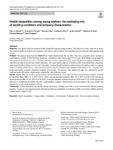2023-10-09Zeitschriftenartikel
Health inequalities among young workers: the mediating role of working conditions and company characteristics
Reuter, Marvin
Pischke, Claudia R.
Rigo, Mariann
Diehl, Katharina
Spallek, Jacob
Richter, Matthias
Hövener, Claudia
Dragano, Nico
Objective Few studies have investigated health inequalities among young workers. The objectives of this study are to assess
the extent of health inequalities in a sample of job starters and to explore the contribution of job demands and organisational
factors.
Methods We analyze data from the BIBB/BAuA Youth Employment Survey 2012. The cross-sectional survey includes a
representative sample of 3214 German employees, apprentices, and trainees aged 15–24 years. Individuals were grouped by
their years of schooling into low (< 12 years) and high levels of education (≥ 12 years). Regression analysis estimated the
link between education and four health outcomes: self-rated health, number of health events, musculoskeletal symptoms,
and mental health problems over the last 12 months. Counterfactual mediation analysis tested for indirect effects of educa-
tion via working conditions (i.e., physical and psychosocial job demands) and company characteristics (i.e., company size,
health prevention measures, financial situation, downsizing). All analyses were adjusted for age, sex, nationality, region,
working hours, job tenure, employment relationship, and economic sector.
Results Highly educated workers reported better self-rated health (b = 0.24, 95% CI 0.18–0.31) and lower numbers of health
events (Rate Ratio (RR) = 0.74, 95% CI 0.67–0.82), musculoskeletal symptoms (RR = 0.73, 95% CI 0.66–0.80) and mental
health problems (RR = 0.84, 95% CI 0.76–0.93). Total job demands explained between 21.6% and 87.2% of the educational
differences (depending on health outcome). Unfavourable company characteristics were associated with worse health, but
showed no or only small mediation effects.
Conclusions Health inequalities are already present at the early working career due to socio-economically stratified working
hazards. To enhance prevention measures that aim at reducing inequalities in workplace health, we propose shifting attention
towards earlier stages of life.
Dateien zu dieser Publikation

